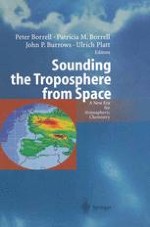2004 | OriginalPaper | Buchkapitel
Retrieval of Aerosol Properties from Satellite Data
verfasst von : Gerrit de Leeuw, Jolanta Kusmierczyk-Michulec, Cristina Robles Gonzalez, Rob Decae
Erschienen in: Sounding the Troposphere from Space
Verlag: Springer Berlin Heidelberg
Enthalten in: Professional Book Archive
Aktivieren Sie unsere intelligente Suche, um passende Fachinhalte oder Patente zu finden.
Wählen Sie Textabschnitte aus um mit Künstlicher Intelligenz passenden Patente zu finden. powered by
Markieren Sie Textabschnitte, um KI-gestützt weitere passende Inhalte zu finden. powered by
Algorithms for the retrieval of aerosol properties over land and over sea have been developed by the TNO Physics and Electronics Laboratory (TNO-FEL) for several instruments, such as AVHRR (Veefkind et al., 1998a), GOME, ATSR-2 (Veefkind et al. 1998a, b; 1999) and OMI (Torres et al. 2002). OMI will be launched in 2004. An algorithm for SCIAMACHY is developed for application over water and over land (Kusmierzcyk-Michulec and De Leeuw 2002a).In these algorithms, different techniques are applied, depending on the instrument properties . The current emphasis is on the Along Track Scanning Radiometer (ATSR-2) on board the ESA Earth Remote Sensing satellite ERS-2. ATSR-2 offers two views, nadir and forward. The nadir view is used over water, where simple assumptions can be used to separate the surface reflectance from the aerosol effects. Over land both views are used. Initially, the single and dual view algorithms have been applied over the US east coast and Europe, with a relative simple description of the aerosol composition in terms of sea spray and “continental” aerosol. However, over other areas the situation can be more complicated due to the occurrence of other aerosol types with different optical properties, such as black carbon, dust and biomass aerosol. In particular when none of these aerosol types dominates it is difficult to determine the influence of each of them on the aerosol optical depth (AOD).This challenging problem has been studied using data from the INDOEX (India and Indian Ocean, see Figure 3.7.1) experiments in February and March 2000 and the SAFARI experiments over South Africa in September 2000. In the INDOEX area the aerosol consists of a complicated mixture of five or more aerosol types. An algorithm has been developed with look up tables (LUTs) that describe the influence of these aerosols on the radiation received by the ATSR-2. A result from this algorithm is presented in Fig. 3.7.1, which is a composite of retrieved AOD for the duration of the INDOEX experiment. Over land the dual view algorithm has been used, over water the single view algorithm. The algorithm also provides the aerosol type, which over land is anthropogenic which changes gradually to maritime as the air mass is advected over sea. The Ångström coefficients have been used to determine the spatial distribution of Be in the area using the method described in (2002b). Results from these retrievals compare favourably with ground-based data, as described in Robles Gonzalez et al. (2003a). The algorithm is now further developed for biomass aerosol, using data from the SAFARI experiments. Initial results are encouraging (Schmid et al., 2003).Apart from the INDOEX and SAFARI experiments, ATSR-2 retrieved AOD maps over Europe are available for October 1995, August 1997, and April, May and October 1999. The ATSR-2 algorithm is being converted to a user-friendly algorithm that can be used to handle large data sets to retrieve aerosols over extended areas and long periods. It will be applied for AATSR on ENVISAT. Results will be madeavailable on the TEMISwebsite (www.temis.nl). Fig. 3.7.1Composite map of the mean AOD at 0.659 μm retrieved using ATSR-2 data for February and March, 1999 over the INDOEX area. Over white areas no data is present
